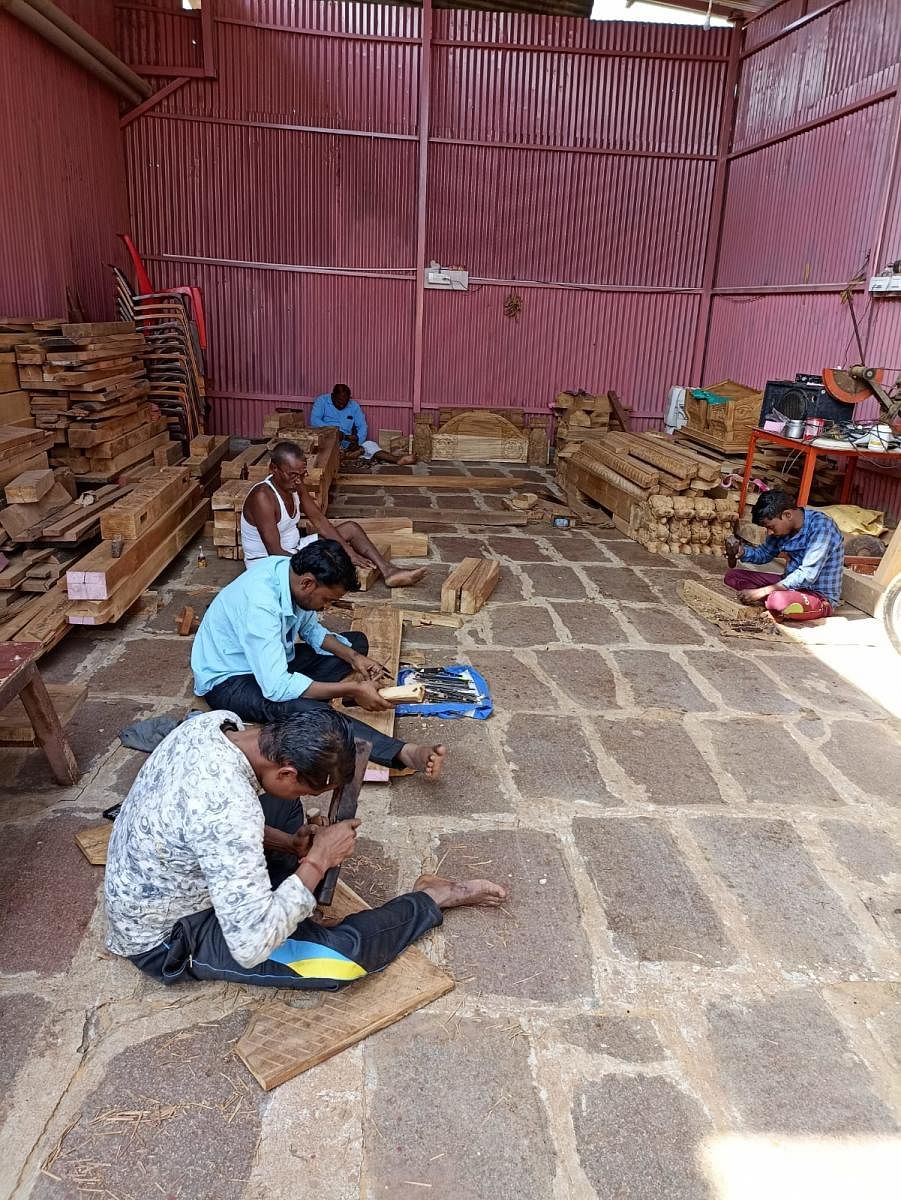

Nagalingappa Badiger is in deep thought. The 76-year-old is crouched on the floor amidst a huddle of wooden blocks at his workshop in Holealur Gadag’s Ron taluk.
Then, he goes to work. With a chisel and hammer, his ageing fingers skillfully create a stunning design of mythological figures on a wooden door frame.
“I have been into this craft since I was 25 years old. Staying in my grandparent’s home, I grew up seeing my uncles involved in wooden craft,” Nagalingappa says.
“Slowly, my ears got used to the ‘music’ of the wooden workshop and my hands began moving towards the craft,” he adds.
Nagalingappa hails from Holealur, a small town on the banks of the Malaprabha, renowned for its community of artisans that have kept alive the tradition of crafting handcarved wooden items, especially door frames. Today, there are still around 150 families who make a livelihood from the craft.
A senior artist who is renowned for his deft woodwork, Nagalingappa says he learnt the craft under Balappa Badiger, another expert
Though there is no clear written evidence about when this art form began in Holealur (historically known as Vatapura). It seems to have gained a footing here during the early Chalukyan and Kalyani Chalukyan era.
“Holealur is geographically close to Badami, a cradle of stone architecture. Though the wood art of the region is much older, the stone art of Badami definitely influenced the wooden art and this is evident from the style of motifs traditionally used by the artisans here,” says Prof R H Kulkarni, an art historian hailing from the area who is currently based in Bengaluru.
He adds that having a door jamb (vertical portion of a door frame into which a door is secured) made in Holealur is a sort of custom in the region and these can be seen adorning several old temples and houses including Shirsangi Wada even to this day.
Different styles
The artisans here even make windows, rathas (chariots) used in temples, simhasana (chairs used by seers), utsav murthy (divine idols), pallakki (palanquins), mantaps (used to place idols of God), and other wooden items.
The chariots prepared by Holealur Fartisans can be seen at the Channabasaveshwar Temple in Ulavi, Gavisiddeshwar Temple in Koppal, Mallikarjun Temple at Srisailam, Mapsa Shanteri Temple in Goa and other places.
To cater to the modern-day demand, the artisans also make sofas, coffee tables and others with intricate carving.
The door jambs are Eka Shakha, Dwi Shakha, or Pancha Shakha, which means that there are either one, two or five layers of frames around the doors. Motifs of mythological figures (Shiva, Ganesha, Vishnu, Laxmi, Narasimha), flowers, creepers, animals like elephants, peacocks, Bhagavad Gita, and others inspired by the Chalukyan architecture are traditionally engraved on each of the frames and doors.
These wooden items initially grew popular through the annual Banashankari fair in Badami — where they were featured right at the door. Now, they are in demand not just in Karnataka, but also in Andhra Pradesh, Telangana, Tamil Nadu, Maharashtra and other parts of the country.
Traditionally, Holealur’s artisans have used teak for their work. The proximity of the Malnad region, where the wood is abundantly available, was also a major factor in the art flourishing.
However, artisans have started using other woods to ensure their work remains affordable.
“It takes six people at least a year to prepare a chariot and a minimum of 15 days to a month to carve a doorjamb,” says 42-year-old artisan Mahesh Hebballi.
“While the doorjambs cost anywhere between Rs 25,000 to Rs four lakh, the chariots cost Rs 50 to 60 lakh.”
Primarily, the art was confined to the Vishwakarma or the Badiger (carpenter) community, but in the last few years, people of other communities, including Muslims, have learnt the art and carried it forward.
“Earlier, there were only a few families which were practising this ancient art form and they mostly catered to the local region. But thanks to digital technology, people from across the country now approach us, and more people are learning it,” says Nagalingappa.
Of late, the village has faced a few setbacks. Floods caused crores of damage as valuable timber was lost. And Covid has crashed demand. But the artisans have been steadily working to get their trade back on track.
“There is a huge demand for our art work but the major issue we are facing is labour problems. We want more people to help us out,” says artist Basavaraj Badiger.
Watch the latest DH videos here: